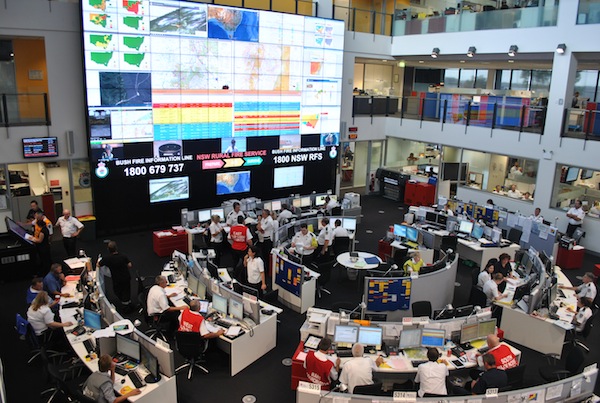In January, Australia was struck by many disasters such as bushfires and floods. First of all, I would like to offer our deepest condolences and sympathy to the victims of the disasters.
On the 18th of January when the temperature got up to 46 degrees in Sydney, I had a chance to visit the New South Wales Rural Fire Service (RFS) headquarters and see the actual disaster management operation in action against bushfires.
Staff of the RFS were working hard against the bushfires in cooperation with other disaster management organisations.
One of the differences I saw with the disaster management system between Japan and Australia (NSW) is that disaster management organisations in Australia are more specialised and divided based on the types of disasters and the purpose of the disaster management. For example, RFS is responsible for bushfires and SES (State Emergency Services) is responsible for floods. Also, there are other organisations such as Fire and Rescue and Ambulance Service. When a disaster happens, they come together to work effectively and efficiently.
In Japan, fire defense departments are responsible for all of the tasks mentioned above, everything from preventing and minimising damage due to fires, floods, earthquakes and other disasters. Their disaster management operations include fire extinguishing, fire prevention, search and rescue, ambulance and flood prevention activities. I think the difference of the system between the two countries is mainly because of the difference of cultural, historical and geographical backgrounds.
I was deeply impressed to hear that staff of RFS and SES who are fighting against disasters are mostly volunteers. In Japan we have about 160,000 conventional fire fighters and 900,000 volunteer fire fighters. In both countries, volunteer staff play a very important role in disaster management.
I would like to pay my respects to the volunteer staff who fought against the bushfires and floods, and hope that the Australian local governments will reconstruct the disaster stricken areas as quickly as possible.







 12月3~13日、福岡県水泳連盟の選抜選手8名がNSW州を訪問し、現地の学校との合同練習とNSW州の大会に参加しました。
12月3~13日、福岡県水泳連盟の選抜選手8名がNSW州を訪問し、現地の学校との合同練習とNSW州の大会に参加しました。

